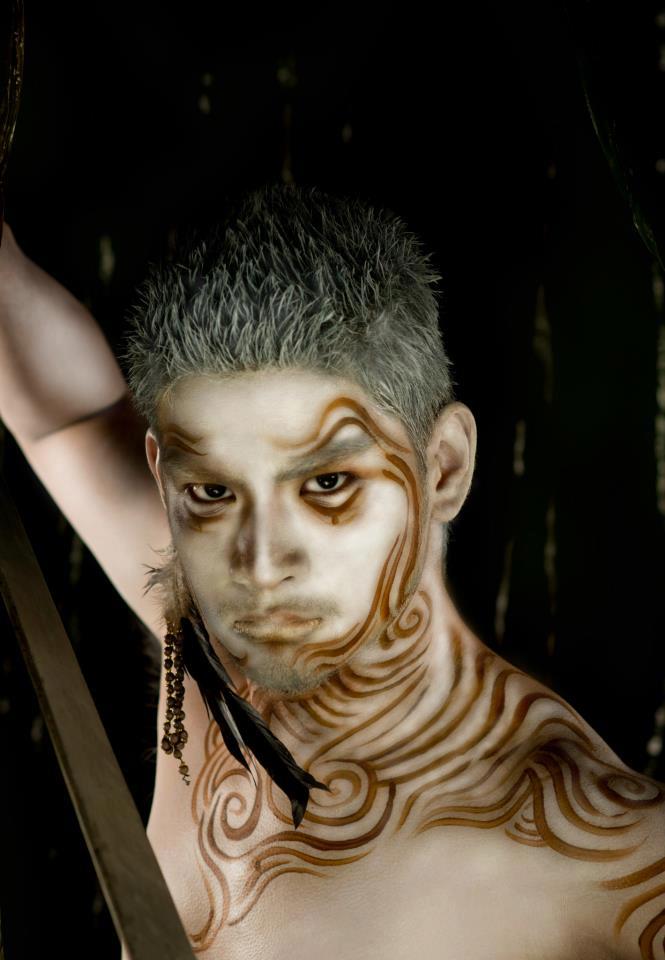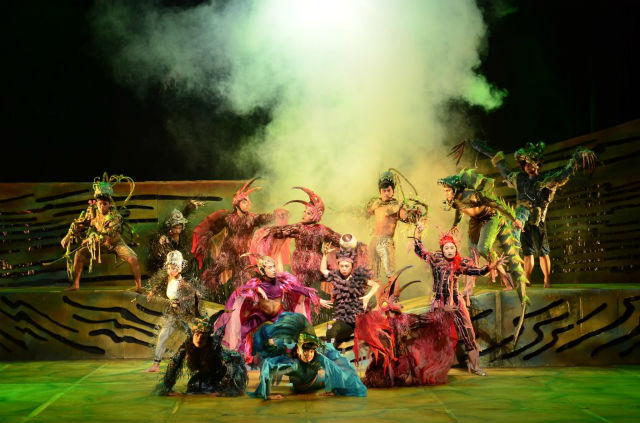Filtered By: Lifestyle
Lifestyle
Theater review: 'Ibalong''s imagination
By KATRINA STUART SANTIAGO
It is context that makes Tanghalang Pilipino’s “Ibalong The Musical” extraordinary. And it is context that is not just about musical franchises with Manila versions, as it is also about context that is a national inability to appreciate the past, be it in terms of history or literature. We are known for our short memories if not our collective amnesia. Most of the time, we prove that correct.
And then there are those times, few and far between, when we are surprised that others are making us remember.
More than retelling

Nicolo Magno rises as Baltog
More than a remembering, this production of “Ibalong” is a daring reconfiguration that invigorates the original Bicolano myth with contemporaneity. That of course might have plenty to do with the music and the costumes here, but a chuck of the credit must go to the original adaptation that can only drive the whole musical together. Which is to say that the libretto itself is able to work with the greatness of an epic and well, make it epic for these times. It takes from the original myth’s 60 stanzas, and is able to reimagine a contemporary musicale.
And when I say contemporary I mean that it allows for the audience to get carried away by the sheer size of it: the fact that it speaks of the breadth and scope of nature, and the heavens, of being human, unlike how we even think of it now.
Yes, the text can only really speak to the present, which usually means losing sight of what that present would be willing to hear, if not how it likes its information filtered. But here, “Ibalong” survives without forcing the parallelisms between then and now, without spewing motherhood statements about the need to save nature and the horrid things people do. It’s all done succinctly, with no point that’s belabored, no part of it repeated to the point of redundancy.
Because as myth, this is the trap that the less creative—maybe the less adventurous— would fall into: the telling that becomes too much of a sermon, almost haranguing an audience for its misdeeds. It’s the kind that becomes rhetoric and nothing else.
Without the baggage of teaching a lesson, “Ibalong” is able to tell a story of good and evil, mortal and immortal, gods and creatures and humans, without having to point a finger at us. Instead it becomes a grand display of what we all are still, where we all come from, and ultimately who we might all still become. In the right hands, and oh so rarely in the Philippines, this is what we learn from our past.
And not just love
The success of that script of course is in this cast and it’s daring. And I don’t just mean capably doing these characters, as it is breathing life into characters that could easily have been mere archetypes, one-dimensional, and nothing else but fiction. Certainly central to “Ibalong” is the romance between half-serpent half-woman Oryol and warrior hero Handyong; it is easy to think this is “the real” in this fiction that this contemporary audience would fall for. And yet given the way the rest of that stage was inhabited by creatures far larger than these two, this particular love played out to seem secondary.

Jenine Desiderio as Oryol, the heroine of Ibalong
On that stage, what became infinitely more powerful as a concept were the dichotomies, where the narrative of love and humanity (that is in the love of Oryol and Handyong) is shown to only exist because of this existing structure. What is of course infinitely interesting in “Ibalong” is the fact that this structure of dichotomies isn’t clearly about the opposites of good and evil; instead no side is one-dimensional, nothing is black and white as we know it, and the gray areas is what we are allowed to imagine.
Say the seeming opposition in Gugurang and Asuwang, Goddess of the Upper World and God of the Underworld respectively, where the normal assumption is that of good versus evil. Here, this dichotomy is rendered unstable by the fact of Oryol’s mere existence as half-human half-serpent, daughter of Asuwang, yet compassionate and kind, protective of the land she inhabits, if not the skies she lives off. Say the idea that Baltog and Handyong are merely evil colonizers, humans who claim land because they can, who imagine development and change to be the end all and be all. Yet these characters’ evils are tempered by the fact that nature’s creatures are not ones to be defined as simply good.
Of course all this could only come across to a spectator given choreography that’s apt and exciting, costumes that are distinctly about a dichotomy between human and creature, and music that echoes in one’s head.
An ensemble unleashed
While Jenine Desiderio wears the character Oryol like second skin—if not a couple of layers more, and Myke Solomon was a competent Handyong (I still think his turn as Gloster’s son Edgardo in PETA’s “Haring Lear”, it was the ensemble of “Ibalong” that could only be described as awesome.

An ensemble that awes in "Ibalong The Musical'
And I do mean mouth agape at hearing and seeing these creatures, fictional yet fascinatingly possible as real, as neither good nor evil. Save for May Bayot as Gugurang—who missed a couple of notes and seemed to be having a difficult time singing—the rest of that ensemble were en pointe, where their movements seemed to be under some form of control, even as being creature could easily be about going all crazy on stage.
The actors who played the human soldiers and warriors might have had a more difficult time, where moving in unison was crucial to the notion of order and change that they stood for. Nicolo Magno as Baltog in particular works into these movements a clear layer of machismo, one that isn’t sacrificed in the face of litheness and grace—quite a rare thing. The swiftness of Cheeno Macaraig as the Young Handyong on that stage is a joy to watch, too.
It is for these reasons, and everything here from the adaptation to the libretto to the music, the choreography to the costumes, and across that ensemble of actors on stage, that “Ibalong” becomes more than just about love and romance. Here, what one finds is how much larger that stage is than the musicale’s leads. This staging is an ensemble performance, one filled with a passion that is the same for both good and evil, mortal and immortal, and all the gray areas in between.
It is fervor, it is desire, that renders them all the same after all. It is also what makes these characters resonate for us, where they can merely and simply be exactly like us. Right here is the value of this telling of “Ibalong” for these times. —KG, GMA News Press photos from Tanghalang Pilipino
Rody Vera adapted for the stage and wrote the libretto of “Ibalong The Musical.” It was directed by Tuxqs Rutaquio for the Cultural Center of the Philippines’ Tanghalang Pilipino, with music by Carol Bello, choreography by Alden Lugnasin, and costumes by Leeroy New. The production will stage “Ibalong the Musical” in Bicol in August of this year.
Katrina Stuart Santiago writes the essay in its various permutations, from pop culture criticism to art reviews, scholarly papers to creative non-fiction, all always and necessarily bound by Third World Philippines, its tragedies and successes, even more so its silences. She blogs at http://www.radikalchick.com. The views expressed in this article are solely her own.
More Videos
Most Popular



